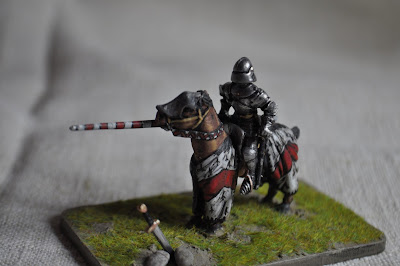Here’s
Sir Thomas Malory of Newbold Revel c1416-1471, at the time of Towton, a
retainer of Richard Neville.
The
figure and horse are both from Essex’s medieval range.
This
is the first figure I have had to take a , modest, leap with - in terms of
research, the most demanding painting of heraldry and the question as to
whether he was even present at Towton. However, the evidence seem credible and
worth the risk, to produce a middle ranking combatant with such a detailed, albeit
ambiguous back story, some character to put it mildly, an a historically
important individual in his own right.
Thomas
Malory of Newbold Revel was a retainer of two successive Earls of Warwick,
Richard Beauchamp
and Richard Neville. Malory had a colourful career that reflects the Bastard
Feudalism of the time. He was a landowner in Warwickshire, Justice of the
Peace, and MP. However he also appears to have played a significant role in the
lawlessness of the period and was involved in a series of incidents that
suggest a serial criminal. In 1443 he was charged, with an accomplice of kidnap
and theft, and then in 1451 charged but not found guilty of ambushing the
Lancastrian Duke of Buckingham. This was possibly at the behest of Beauchamp. A
series of alleged violent crime followed including robberies, horse stealing
and possibly rape. He was imprisoned and escaped or released three times before
1461, but except for the 1451 incident never charged. And some argue the
allegations against him was a fabrication by the Duke of Buckingham.
In later years, he was active in Warwick’s plots
against Edward IV and was thus imprisoned again in 1468 only to be released
from prison for a final time during the brief 1470 reign of Henry VI. One
assumes this was as a result of Warwick’s lobbying. Malory died in 1471 and was
buried at Christ Church, Greyfriars, London. His tomb epitaph reportedly made
reference to him being a “valiant soldier”.
Malory, is most well-known for his literary rather than
military legacy. He is widely believed to be the author of Le Morte d'Arthur,
the first major work of English language prose. Whilst there were at least six
other Thomas Malorys alive at the same time and others suggested as the author,
the Newbold Revel one is seen as the prime contender. Several references to the
author being a “knight” and “knight prisoner” are in Caxton’s 1485 printed
edition of the book. As the Arthurian scholar, PJC Field, suggests "he was
the only knight of the right name alive at the right time" and with access
to earlier manuscript versions of the Arthurian story. Malory probably had
access to these books from Greyfriars’ library when he was jailed in
Newgate.
It is argued that Le
Morte d’Arthur was a political critique of Malory’s own time - a period of
weak kingship, insecurity and violence that followed an idealised period of
unity and strong kingship under Henry V.
The debate about his presence at Towton remains open. The
Towton Society database of combatants lists Malory as present at the battle
but other sources do not. He was definitely in prison in 1460 and only pardoned
by Edward IV on the latter’s accession, in March 1461. If he was released at
the time, his links to Warwick and the massive muster both sides undertook
before Towton, it is plausible he followed Edward and Warwick northward. Field
argues in 'Malory and the Battle of Towton' , that the descriptions of warfare and especially of post-battle looting in Le Morte d’Arthur suggest
Malory fought in the Wars of the Roses and especially the unprecedented
large-scale carnage of Towton. Other academics question this. They argue that
previous versions of the Arthurian legends contain similar graphic accounts of
war and thus Malory’s texts cannot be used as evidence of his participation at
Towton.
The final uncertain is to his coat of arms. Field argues there is some uncertainty on the
subject. He describes this problem over 6 pages in his excellent Life
and Times of Sir Thomas Malory.
Whilst noting the debate, Field ultimately
decides on:
Quarterly 1 & 4 ermine a chevron gules and a
border engrailed sable; 2&3 or three lions passant sable.
So here is my representation of Malory, a figure whose life,
career and mixed character and the evidence on whom seem to epitomise the
complex times - involved in the highs and lows of C15th bastard feudalism;
ruthless even criminal behaviour, evading justice and producing a classic of English
literature.





